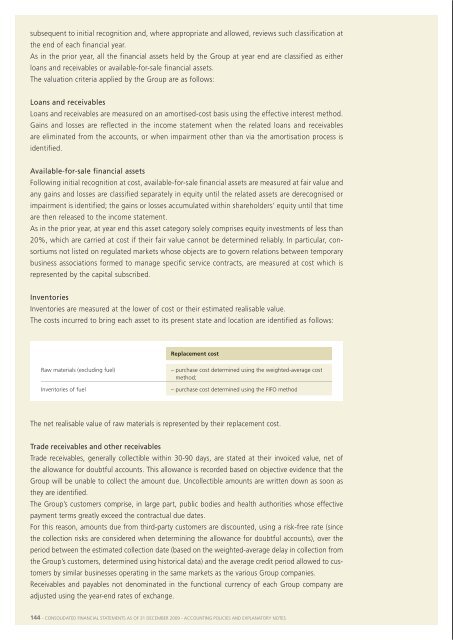Financial Statements 2009 - Manutencoop
Financial Statements 2009 - Manutencoop
Financial Statements 2009 - Manutencoop
You also want an ePaper? Increase the reach of your titles
YUMPU automatically turns print PDFs into web optimized ePapers that Google loves.
subsequent to initial recognition and, where appropriate and allowed, reviews such classification atthe end of each financial year.as in the prior year, all the financial assets held by the group at year end are classified as eitherloans and receivables or available-for-sale financial assets.the valuation criteria applied by the group are as follows:loans and receivablesloans and receivables are measured on an amortised-cost basis using the effective interest method.gains and losses are reflected in the income statement when the related loans and receivablesare eliminated from the accounts, or when impairment other than via the amortisation process isidentified.available-for-sale financial assetsfollowing initial recognition at cost, available-for-sale financial assets are measured at fair value andany gains and losses are classified separately in equity until the related assets are derecognised orimpairment is identified; the gains or losses accumulated within shareholders’ equity until that timeare then released to the income statement.as in the prior year, at year end this asset category solely comprises equity investments of less than20%, which are carried at cost if their fair value cannot be determined reliably. in particular, consortiumsnot listed on regulated markets whose objects are to govern relations between temporarybusiness associations formed to manage specific service contracts, are measured at cost which isrepresented by the capital subscribed.inventoriesinventories are measured at the lower of cost or their estimated realisable value.the costs incurred to bring each asset to its present state and location are identified as follows:replacement costraw materials (excluding fuel)– purchase cost determined using the weighted-average costmethod;inventories of fuel– purchase cost determined using the fifo methodthe net realisable value of raw materials is represented by their replacement cost.trade receivables and other receivablestrade receivables, generally collectible within 30-90 days, are stated at their invoiced value, net ofthe allowance for doubtful accounts. this allowance is recorded based on objective evidence that thegroup will be unable to collect the amount due. uncollectible amounts are written down as soon asthey are identified.the group’s customers comprise, in large part, public bodies and health authorities whose effectivepayment terms greatly exceed the contractual due dates.for this reason, amounts due from third-party customers are discounted, using a risk-free rate (sincethe collection risks are considered when determining the allowance for doubtful accounts), over theperiod between the estimated collection date (based on the weighted-average delay in collection fromthe group’s customers, determined using historical data) and the average credit period allowed to customersby similar businesses operating in the same markets as the various group companies.receivables and payables not denominated in the functional currency of each group company areadjusted using the year-end rates of exchange.Contracts for the construction of buildings and planta construction contract is a contract signed specifically for the construction of an asset commissionedby a principal, who determines the initial design and technical characteristics.the contract revenues comprise the consideration initially agreed with the principal, as well as thechange orders and the price variations envisaged in the contract that can be determined reliably.When the results of contracts can be determined reliably, they are measured on a percentageof-completionbasis; the stage of completion is determined with reference to the contract costsincurred at the balance sheet date as a percentage of the total costs estimated for each contract(cost-to-cost basis).if the contract costs are expected to exceed total contract revenues, the expected loss is recognisedimmediately as a cost.the gross amount due by contract principals, for all contracts in progress where the costs incurredplus the margins recognised (or less the losses recognised) exceed the progress billings made, is recognisedas a receivable and, as such, classified among the “trade receivables”. the gross amountdue to contract principals, for all contracts in progress where the progress billings made exceed thecosts incurred plus the margins recognised (or less the losses recognised), is recognised as a payableand, as such, classified among the “trade payables”.Cash and cash equivalentsthe liquid funds and short-term deposits included in the balance sheet comprise cash on hand,demand deposits and short-term deposits with an original maturity of not more than three months.loansall loans are initially recorded at the fair value of the amount received, net of related loan-arrangementexpenses.following initial recognition, loans are measured on an amortised-cost basis using the effectiveinterest method.in addition to the amortisation process, all related gains and losses are reflected in the incomestatement when the liability is settled.elimination of financial assets and liabilities<strong>Financial</strong> assetsfinancial assets (or, where applicable, parts of financial assets or parts of a group of similar financialassets) are eliminated from the financial statements when:> the contractual rights to receive the cash flows generated by them expire;> the group has transferred the financial asset (transferring the right to receive the cash flows derivingfrom the asset or retaining the right to receive them, but accepting the contractual obligationto pay them in their entirety and immediately to another party), together with substantiallyall the risks and benefits deriving from ownership of such asset.if, as the result of a transfer, a financial asset is derecognised in full but, as a consequence, thegroup obtains a new financial asset or accepts a new financial liability, the group recognises at fairvalue such new financial asset, financial liability or liability originating from the service.<strong>Financial</strong> liabilitiesfinancial liabilities are derecognised when the underlying obligation is eliminated, cancelled orsettled.if an existing financial liability is replaced by another from the same lender on substantially differentterms, or the conditions applying to an existing liability are modified significantly, this replacementor modification is recorded by eliminating the original liability and recognising a new liability. anydifferences between the carrying amounts concerned are reflected in the income statement.144 - Consolidated finanCial statements as of 31 deCember <strong>2009</strong> - aCCounting poliCies and explanatory notes Consolidated finanCial statements as of 31 deCember <strong>2009</strong> - aCCounting poliCies and explanatory notes - 145








